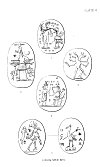
The Gnostics and Their Remains, by Charles William King, [1887], at sacred-texts.com

The Gnostics and Their Remains, by Charles William King, [1887], at sacred-texts.com

Click to enlarge
Plate G
1. In this composition an element from a little-used source is introduced. The Grecian Apollo, distinguished by his proper attribute, the bay-branch, is seen caressing the Ibis, sacred to Thoth, scribe of the gods. The latter deity being identified with Hermes, his bird carries the caduceus; it also bears upon its head the corn-measure, typical of abundance.
2. The Ass-headed Typhon, or the Principle of Evil, with quadruple
wings and one foot hoofed, carries by the tail two monstrous scorpions: over his head a scarabæus flying. Of no esoteric meaning, but simply an amulet against the bite of the reptile, made after the rule in such cases prescribed. The most convincing proof of the practice is the early Greek gem published by Gen. Cesnola ('Cyprus.' pl. xl. 17), representing two asps, with the explanation ΕΧΚ; and to this day the Arabs always draw upon their amulets the figure of the thing against which it ought to guard the wearer.
3. A Dual Power, who combines the jackal's head of Anubis with the ass's head of Typhon, whence one of his feet is hoofed, brandishes in his four hands swords and torches, wherewith to scare away the evil spirits. The legend on the reverse, ΠΕΡΑΑΜΒΑ VΒΑΚΑ ΚΞΙΚ Λ, has not been read, but contains the Coptic name of Anubis.
4. The Sun-god, Phre, with radiated head, adoring the seated Thoth, ibis-headed, and using the invocation (cut on the reverse) "Thou art our Father!" Inasmuch as the Neo-Platonists made Hermes to be the Power that regulates the motion of the heavens (for which reason Julian addressed his morning prayer to him), there is evident reason why the god of Day should thus do homage to Thoth as his superior and director.
5. A very popular Gryllus, its components being the emblems of the elements--the Bird standing for air; the Lion for Fire; the Ram's head for Earth, and the Bacchic mark for water. This Pagan talisman has been Gnosticised by Thoth's ibis, with the Holy Names, "Abraxas" and "Iao;" but the work on both sides is evidently from the same hand, and in the style of the fourth century. The material is a rarely-used stone--obsidian.